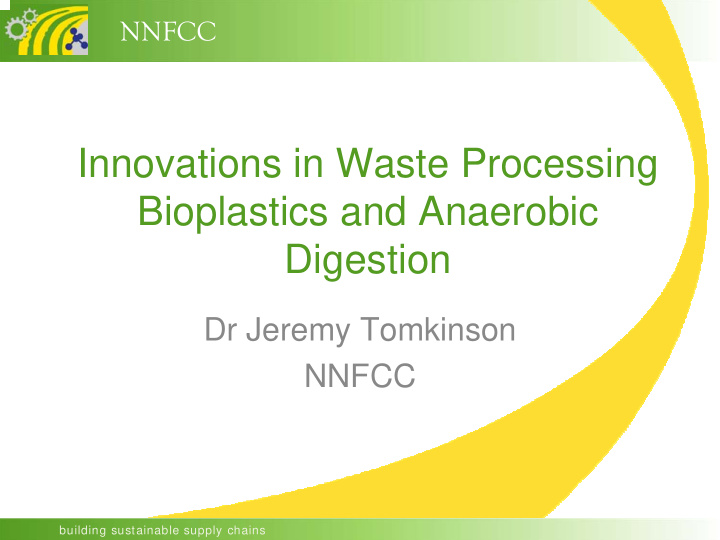



NNFCC Innovations in Waste Processing Bioplastics and Anaerobic Digestion Dr Jeremy Tomkinson NNFCC building sustainable supply chains
NNFCC Average weekly Shop • Filmic Materials 10’s of KT’s • Paper and board 100’s of KT’s building sustainable supply chains
NNFCC Packaging Images courtesy MaterBi building sustainable supply chains
NNFCC Packaging building sustainable supply chains
NNFCC Packaging More complicated lightweight packaging entering UK market, e.g. • microwavable soup sachets • coffee sachets • Twinings tea • All are v difficult to recycle or reuse as multi laminates of different materials • if biodegradable then no need to depackage and recover as packaging and food could go to AD plant for energy recovery building sustainable supply chains
NNFCC Bioplastics – C/N ratio • Bioplastics contain renewable resources, they produce biogas during biodegradation and the residual matter and biomass produced remain in the digestate / compost • Biowastes esp kitchen waste can have high protein levels • low C/N ratio (<20) • can lead to high ammonia levels • reduced digestion rates • Bioplastics are virtually all carbohydrates with little or no nitrogen • high C/N Ratio • low ammonia levels • maximised CH 4 / energetic output building sustainable supply chains
NNFCC Bio-based degradable plastics Evolution of biogas from cellulose (red) compared to a selection of Bio- based packaging films through high-rate dry anaerobic fermentation building sustainable supply chains
NNFCC Biomethane potential of UK food waste and primary food packaging tpa volatile biomethane Gas energy As proportion As proportion solids content of 49 TWh of 117 TWh RES heat RES target electricity target % VS m 3 TWh % % Food 7,000,000 23.3 768,201,000 8.05 16.4 1.2 Packaging 240,000 95 89,148,000 0.93 1.9 0.1 Anaerobic Treatment of Packaging Waste 09-011 NNFCC Report - Southampton University building sustainable supply chains
NNFCC Bio-based degradable plastics • Films, trays and bags are the most common forms of food packaging materials with the bio based offering valuable and in some cases unique physical properties • If we could digest all the filmic packaging materials used in foods we could generate in excess of 270 million cubic metres of biogas - PCI report 2007 • Taking a more realistic scenario of only 10% EU market penetration this is enough to generate 54 GWh of power per annum • EU Renewable energy generation would increase at a rate of ca 5 GWh for every 1% of petrochemical derived plastic film converted to biodegradable plastic film. building sustainable supply chains
NNFCC www.nnfcc.co.uk Website: www.nnfcc.co.uk Email: I.1234567891@nnfcc.co.uk building sustainable supply chains
NNFCC UK ON-Pack Labelling building sustainable supply chains
NNFCC Home Composting building sustainable supply chains
NNFCC Home Composting building sustainable supply chains
Recommend
More recommend